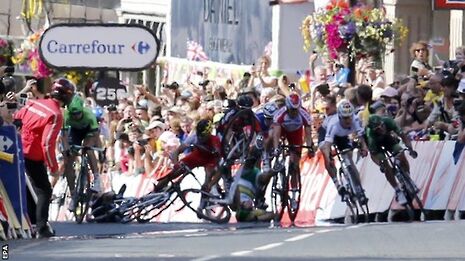La Folie du Tour: Why Cycling’s greatest event needs modernising, and fast
As another controversy-laden Tour de France draws to an end, Charlie Stone argues it is time to tackle the root of the problem

The aftermath of Chris Froome’s crash with Australian cyclist Richie Porte during Stage Twelve of this year’s Tour de France offered a vague confirmation of some longstanding doubt that has been at the back of my mind.
Porte had crashed into a motorbike, slowed due to spectators encroaching upon the course up ahead. And to make matters worse, another cyclist and another motorbike had hit the back of the resulting melee. But before the French commentators had even had enough time to exclaim their glee at seeing the collapse of the favourite, we witnessed probably the most farcical moment in 113-year old Tour’s history: the wearer of the Yellow Jersey running up a mountain, carrying his mangled bicycle along with him.
That vague doubt now became a reality in my mind: the Tour’s organisers simply do not know how to deal with fans. Seeing a cyclist sprinting up a hill, trying to get on one bike and failing, then finally getting on his team’s spare bike before crossing the finish line far behind his rivals undoubtedly makes for fantastic viewing, but it does raise a serious – and regrettably recurring – question.
Why are the spectators allowed so freely to enter the cyclists’ route?
Soon after Froome had crossed the line shaking his head in disappointment, it was announced that the stage result had been annulled, and all finishing times would be taken from the point at which the crash took place. This seemed fair enough at first: it was not Froome’s fault that over-excited spectators rushing onto the route had caused a potentially dangerous crash. But it does seem also to have missed the point.
For one thing, this decision effectively deleted the efforts of the general classification competitors in the last leg of the race. Furthermore, there was a conspicuous lack of statement – or action – towards the spectators. The Tour de France attracts 12 million roadside fans every year and there are typically no barriers preventing these from running onto the route and obstructing the cyclists. And this is by no means a new issue: Tour riders have been calling for more protection from the fans for years, but it seems that we are no closer to what is surely an easy solution. Simply put, it is dangerous to let members of the general public have such easy access to the cyclists en route.
Of course – once again – the Tour committee called on spectators to respect the space of the cyclists. But this is redundant: similar to abandoning of security control in airports in favour of politely calling on travellers not to bring anything dangerous on the flights. Tradition and the old-fashioned nature of the Tour are part of its magic and attraction, but nostalgia must surely cede to safety. Last year, a spectator made a poignant and subtle statement of his suspicions that Froome might be doping, by throwing urine in his face along the route. Harmless enough – if a little tasteless – but one cannot help imagine the consequences if something worse than urine had been thrown.
Predictably, the cycling world reacted angrily to the crash, echoing and substantiating concerns about the safety of the competitors. Veteran Fabian Cancerella tweeted, ‘What a scandal today for Le Tour. No safety and too much chaos on Mont Ventoux. This is definitely not what cycling needs. Not enough barriers for safety’. Meanwhile, Trek’s Gregory Rast said: ‘All day we work, fight and suffer and they are too lazy to put barriers on the last km??’
Interestingly too, tweets from Jan Bakelants, a cyclist with AG2R, showed that even flags have become a problem: after Stage Thirteen, Bakelants made a plea with fans to ‘leave [their] flags at home’, arguing that ‘they add nothing and only bring us in danger’ and observing that he had ‘had a bad crash due to a drunk guy with a flag’.
Only on the Tour can a drunk guy with a flag cause so much trouble.
The organisers have acknowledged that there are problems with the format of the Tour. But these seem too much like hollow words. In fact, their acknowledgement of the issues reminded me a bit of myself serving irritated customers at the Henley Regatta: ‘I appreciate your difficulty, sir’, ‘I can see how that is a problem for you’, ‘I’ll go and ask my supervisor to see what we can do’.
But if my supervisor was part of the Tour’s organising committee, then I am confident that my guest would get what he wanted. It is not hard or onerous to put up any sort of barrier to stop eager fans from getting as physically close to the riders as to cause danger. In the worlds of football and rugby, a fan getting anywhere near a player is thrown to the ground by three stewards and escorted straight to the police office to be charged.
In cycling meanwhile, a fan gets near the athlete and the rider is charged £150 for trying to push him away. Earlier on this year’s Tour, Froome himself was fined 200 Swiss francs for the same offense. It does not seem to make any sense.
Undoubtedly, the Tour de France remains one of the world’s greatest sporting events. The nature of the different competitions held within those three grueling weeks, the variety of loudly-coloured jerseys, and the sacrifices a team of cyclists makes for their leading athlete are all part of its magic.
But with great popularity comes great vulnerability.
Indeed, following the tragic events which occurred on Bastille Day in Nice, it is becoming increasingly clear that terrorists do not necessarily prepare meticulously for their attacks. Though it seems Nice was pre-planned and anticipated, concerns should persist that the attack was, in many ways, easy. Famous sporting events, where thousands, even millions, of people turn out, are surely an attractive target for terrorists. And events with as little security as the Tour are seriously vulnerable.
This competition is, and will always be, one of the best. But we must be accepted that a little more security for athletes and fans alike is necessary.
La Folie du Tour is something we love, but we must not allow it to get out of hand.
 Features / How sweet is the en-suite deal?13 January 2026
Features / How sweet is the en-suite deal?13 January 2026 Comment / Will the town and gown divide ever truly be resolved?12 January 2026
Comment / Will the town and gown divide ever truly be resolved?12 January 2026 News / 20 vet organisations sign letter backing Cam vet course13 January 2026
News / 20 vet organisations sign letter backing Cam vet course13 January 2026 Arts / Fact-checking R.F. Kuang’s Katabasis13 January 2026
Arts / Fact-checking R.F. Kuang’s Katabasis13 January 2026 Music / Inside Radiohead’s circle13 January 2026
Music / Inside Radiohead’s circle13 January 2026









